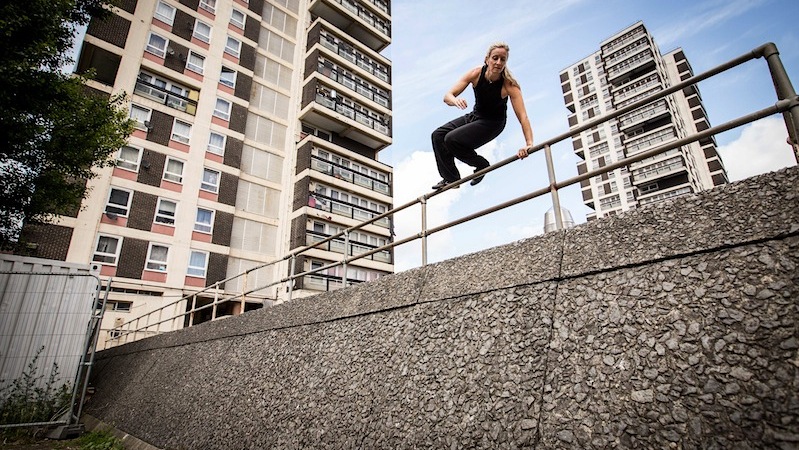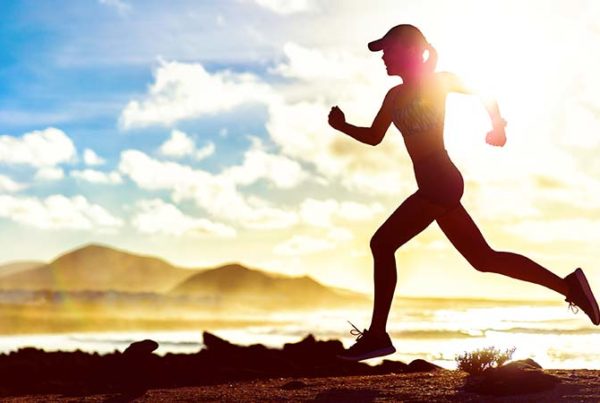
Joy of movement leads filmmaker-author to Ph.D., book and transformation to a life of health and fitness.
Parkour has been described as obstacle racing without a stopwatch or a finish line. For author and enthusiast Julie Angel the discipline has become a “high-flying rebellion” to a sedentary lifestyle.
The 46-year-old filmmaker and artist made Parkour the subject of her Ph.D. studies as well as her new book Breaking the Jump, which serves as the unofficial historical documentary of this largely unknown story.
But while Julie is all about Parkour, her own narrative is one of transformation, movement and health.
Julie discovered Parkour watching a short video on BBC in 2002. In the video, a guy shed his shirt and emerged from his office, then like a real-life Spiderman made his way home rooftop-to-rooftop.
“It was stunning and incredible to the point that people didn’t think it was real,” Julie says.
Mesmerized by the beautiful movement she was at once infected by Parkour, which she now regards as a “sporting creative practice.”
Julie, who had marveled while filming skateboarders performing stunts in an empty California swimming pool, suddenly had a whole new world view. “This isn’t skateboarding. It’s NO-boarding,” she says. “It was much more everyday than the pool skaters.”
There’s always a small wall. There’s always a tree. There’s always a railing, she says. “What kind of person wakes up and sees that outside, and goes out and does that? I’ve never seen people move like that.”
Indeed this is what Parkour is all about. It’s a discipline of movement — running, climbing, jumping, swinging, vaulting and even rolling — often high off the ground in urban environments with no safety net.
From its obscure beginnings in Paris, Parkour took London by storm and then became an international phenomenon. But, in effect, Parkour has been part of the human genetic code for all of our existence, it’s just that many of us in recent generations have suppressed these innate abilities for movement, which would have been crucial to survival for early humans.
It’s is also a practice that requires its participants to be very present, another lost skill for many modern humans.
At once Julie wanted to film Parkour artists, and research the discipline. But what she didn’t know then was that the practice would lead her on her own journey of renewed strength and health.
“Being around these people is just infectious — their creativity and recreation of the environment,” she says. “Play is very transformative.”
This proved to be the case for her as well. Through documenting Parkour, Julie rediscovered the joy of movement, which at that point in her life she had not even realized she’d lost. Her physical condition had deteriorated and along with it her mental and emotional state.
“They inspired me. I wouldn’t be in the physical shape that I am now,” she says. “As we age unless you are regularly challenging to yourself you are just building layers and layers of fear.”
“Once the lid is off it’s like, ‘Oh my God, I am so scared of so many things.’ Through these movements I can deal with them. I can start shedding them off.”
Julie says as a woman it was easy to make a lot of excuses. Watching women in Parkour made her realize that her excuses just didn’t cut it anymore, and that a “culture of effort” was more her style.
“It’s a really beautiful thing actually — a culture of effort,” she says. “How can you be the best version of you? Not what you compare to others.”
Along this journey she also found and adopted a more MAF-style approach to her training and diet.
Initially her workouts left her drained. She was in the middle of her studies and running high stress levels along with her training. A vegetarian since her 20s, she was now experiencing aches and pains, and suffering from crushing headaches. Sometimes training efforts would require four or five days of recovery.
“Everything ached. I couldn’t walk down stairs.”
A visit to a practitioner of Chinese medicine, helped her to adjust her nutrition, which in turn improved her ability to recover from workouts and train more consistently.
After adding fish to her diet, she says she began feeling feeling better and stronger within a week. Later, she excluded grains from her diet and experienced massive improvements in her recovery times.
Eventually Julie added chicken and all meat back into her diet at the suggestion of her now husband, Vic Verdier, also an icon in what some might call the “Movement Movement.”
I knew after one week there was no turning back. I felt full and satisfied. My strength tripled in a month with no change in my training,” she says. “There were obstacles I had been stepping over for years and now I was vaulting over them. It just gave me strength.”
Nowadays, Julie trains slowly and purposefully, through natural movement, plus some weight-lifting and Russian martial arts, often barefoot or in minimal footwear. She says Parkour has taught her to develop real strength, enjoy walking, run properly and be present at all times.
“I’ve done three Crossfit classes in my life and it’s not like that,” she says. “You have to be present and with many of the things there is an element of risk. There is a very low injury rate because you must remain very mindful. You are outside and dealing with the harsh elements of your environment. If you fall, that concrete is going to come out better. This promotes a lot of humility if you want to sustain yourself.”
Moreover, Julie says her journey as been an incredibly powerful and transformative experience, as well as just plain fun.
Along the way she also earned her Ph.D. and wrote Breaking the Jump, and says she has constantly been fascinated by the story of Parkour practitioners. She says her Ph.D. was about the practice and the discipline, and the book is about the who, what, when, why, where and how.
“How people move is impressive. It’s inspiring,” she says. “I would rather be doing baby jumps and being part of something than sitting on my ass and watching someone else do something spectacular.”
..
Photo by Andy Day.








